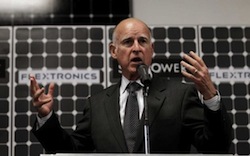California has made yet another move for renewable energy. Last week, Gov. Jerry Brown (D-CA) signed S.B.2X. This new law requires 33 percent of all electricity generated in the state to come from renewable resources by 2020. Apparently concerns over the growth of renewable sources in the state mobilized last year under Prop 23 was not a deterrent to increase the state’s Renewable Portfolio Standard (RPS) from 20 percent by 2020 to now 33 percent by 2020. The American Wind Energy Association (AWEA) applauded California for passage of S.B.2X.
 The bill was signed into law at SunPower/Flextronics solar manufacturing plant in Milpitas, Cali. During the event, Brown indicated that he thinks 40 percent renewable energy production is a feasible goal. In his signing comments, Brown said, “This bill will bring many important benefits to California, including stimulating investment in green technologies in the state, creating tens of thousands of new jobs, improving local air quality, promoting energy independence and reducing greenhouse gas emissions.
The bill was signed into law at SunPower/Flextronics solar manufacturing plant in Milpitas, Cali. During the event, Brown indicated that he thinks 40 percent renewable energy production is a feasible goal. In his signing comments, Brown said, “This bill will bring many important benefits to California, including stimulating investment in green technologies in the state, creating tens of thousands of new jobs, improving local air quality, promoting energy independence and reducing greenhouse gas emissions.
He continued, “Our state has enormous renewable resource potential. I would like to see us pursue even more far-reaching targets. With the amount of renewable resources coming online, and prices dropping, I think 40 percent, at reasonable cost, is well within our grasp in the near future.”
The bill had some challenges to passage until it received a malleable target in Brown. According to an article in Solar Industry Magazine, S.B.2X was a bill that evolved from S.B.14 that was approved by California’s houses, but vetoed by Gov. Arnold Schwarzenegger who did not re-run last year due to term limits. A modified bill – S.B.722- was introduced in December 2010 with strong support, but not enough to pass before the session deadline. The current version, S.B.2X was authored by State Sen. Joe Simitian (D-Palo Alto).
In a press release, Simitian said of his bill, “This bill establishes California as the national leader in the use and development of renewable energy. The new law will stimulate the economy and improve the environment, while protecting ratepayers from excessive costs.”
This new RPS will apply to all electricity retailers in the state including municipal utilities, independent sellers and investor-owned. All of these entities will ramp up their required use with 20 percent of all energy produced from renewables by the end of 2013 and 25 percent by the end of 2016 with the 33 percent requirement being met by the end of 2020.

